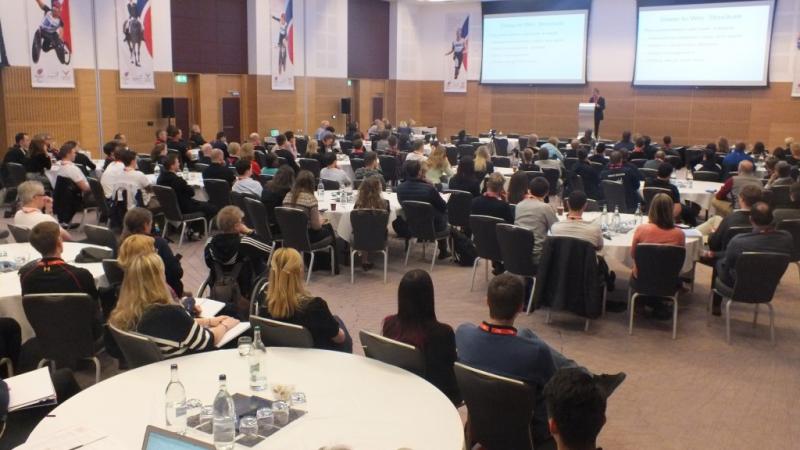PARA SPORT SCIENCE
Sports for people with an impairment have changed drastically over the last few decades, drawing an increase in public awareness, but also from the academic community.
The IPC wishes to create a culture within the Movement about the value of science and to encourage dialogue between the Paralympic Movement and the academic world so that the right questions are asked and responded to.
Initiatives include:
- Helping the different stakeholders in the Movement to put clear questions to the scientists and to identify the right partners.
- Committing to furthering research in the areas of interest of the Paralympic Movement and facilitate research projects at IPC events and competitions.
- Engaging actively in the dissemination of knowledge through thematic research publications and active engagement in different scientific conferences, with VISTA as the most prominent.
Examples of publications with an active engagement of the IPC include:
- Clinical Journal of Sports Medicine (2012, issue 1: Paralympic Winter Games Research)
- Sports Technology (2012, issue 1-2 : Paralympic Sport Technology).
- British Journal of Sports Medicine (2013, issue 7: Paralympic Games Research)
- The Paralympic Athlete (2011). IOC-series ‘Handbooks of sports medicine and science.’
- Training and Coaching the Paralympic Athlete (2016). IOC-series ‘Handbooks of sports medicine and science.’
Examples of thematic research projects under IPC direction:
- Under the 2006 WADA Social Science Grant programme and on behalf of the IPC, the University of Alberta, Canada co-ordinated a study on ‘Autonomic dysreflexia and boosting’. In summary, 99 athletes, vulnerable to autonomic dysreflexia, participated in a questionnaire survey and only a little over half had previously heard of boosting. However, they were strongly opposed to the use of boosting to improve training capacity, enhance performance during competition, and because their competitors were using it. The study generated a series of recommendations that IPC will use as a guideline to develop educational programmes and revisit its event-boosting monitoring programme. The full report can be retrieved from WADA.
- Under the 2009 WADA Science Grants programme, the Swiss Paraplegic Centre (Switzerland) and Catholic University of Leuven (Belgium), conducted a study on the potential performance enhancement effect of Sildenafil (at very high altitudes). This study was initiated in response to WADA adding Sildenafil to the monitoring List for Prohibited Substances in 2008. Many athletes with a spinal-cord injury use these medications to treat erectile dysfunction of neurologic origin. Therefore, it was important to understand what effects, if any, this class of medications has on athletic performance in athletes with spinal cord injury. A total of 27 competitive wheelchair athletes of different sports (e.g. athletics, handcycling, wheelchair rugby, wheelchair basketball, alpine skiing) were tested on an armcrank ergometer after the ingestion of either 50mg sildenafil citrate or placebo one hour before testing. Results showed that sildenafil ingestion did not develop any meaningful improvement in exercise capacity (n=27) or performance (n=15) neither at sea level nor at moderate altitude. In contrast, a negative impact on oxygen saturation, heart rate and lactate concentrations was found for the majority of the tested athletes at moderate altitude. Thus, the use of sildenafil citrate does not lead to ergogenic effects in athletes with spinal cord injury. These findings were part of the final assessment by WADA when they decided not to add Sildenafil on the WADA (world anti-doping agency) list of prohibited substances. The full report can be retrieved from WADA.
- Supported by an IOC Research Grant, the IPC Medical Committee investigated mechanisms of injuries in the shoulder region.
In support of the classification agenda of the Paralympic Movement, the IPC also endorsed scientific position statements on the conduct of evidence-based classification in the Paralympic Movement. These can be found as part of the IPC Handbook:
• IPC Position Stand on Background and Scientific Rationale for Classification in Paralympic Sports (IPC Handbook, Section 2, Chapter 4.3).
• Joint Position Stand on the Sport-Specific Classification of Athletes with Vision Impairment (IPC Handbook, Section 2, Chapter 4.6)
IPC SCIENTIFIC AWARD
Awarded biennially, the IPC recognises the work of one academic researcher for their contribution to research in the field of sports for athletes with an impairment through the IPC Scientific Award. To be eligible for this award, candidates must have contributed through significant scientific publications related to the scientific study of sport for persons with an impairment in any discipline, have received national and/or international recognition for his/her work, and place an emphasis on the practical application of research with direct or indirect benefit to the Paralympic Movement. This award also serves to promote and encourage further study in this area.




